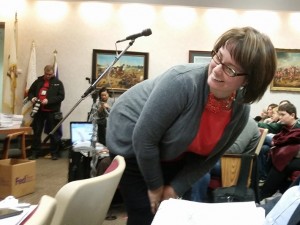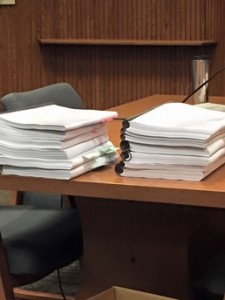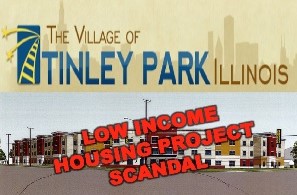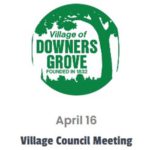Tinley Park, IL. (ECWd) –
On 2/4/16, the Village of Tinley Park held a Planning Commission meeting where its Planning Director, Amy Connolly, refused to speak or answer the public’s questions. Earlier this week, we covered the breaking scandal in this southwestern Chicago suburb where it has so far been revealed that zoning code was changed in a sneaky and underhanded way without proper Board oversight or scrutiny to allow a low income housing project to be fast tracked in what was supposed to be a high-end mixed use commercial/condo development. Now, it appears evidence is being found that documents were faked and fraud was potentially committed by Village employees to improperly push forward a project that should have never been given the green light under existing Village code. You can read our initial coverage here.
You can watch video from the explosive Planning Commission meeting on 2/4/16 here where all hell broke loose and Mayor David Seaman and several Village Board members, including outspoken Trustee Jacob “Jake” Vandenberg, tried to appease angry homeowners by promising to investigate the conduct of Village employees in regards to the Buckeye Community Hope Foundation and the fast-tracking of the low income housing project it wants to build in Tinley Park against local homeowners’ vociferous objections:
PART 1 = https://www.youtube.com/watch?v=X0lO_q5BIRI
Part 2 = https://www.youtube.com/watch?v=VldtGzyamPw
This Planning Commission meeting was a great victory for local government watchdogs and a great day for liberty and democracy in Illinois. Over 1,000 concerned Tinley Park citizens mobilized on 2/4/16 to voice their outrage over Amy Connolly’s behavior as Planning Director and to demand that Connolly fess up and explain why an Ohio low income housing developer was seemingly allowed to push through a neighborhood-changing project with lightning speed in a suburb where ordinary residents are not allowed to so much as erect a simple fence or remodel their garage without multiple personal appearances before the planning commission and mountains of paperwork. A well-organized citizen social media group called Citizens of Tinley Park (https://www.facebook.com/groups/196478400706914/) spread the word that Buckeye was given special treatment by Connolly and that statements the Village had made about the housing projects didn’t hold water and were easily contradicted or refuted, evidencing a shocking amount of deception, obfuscation, or outright lying by Village employees.
Members of the group crowd-sourced review of documents that contradicted statements that Connolly had made at the 2/2/16 Village meeting…and this team effort revealed that Connolly had corresponded with Buckeye about zoning changes being made which would allow the low income housing project to slip through (unnoticed by residents since Buckeye would never be made to come before the Planning Commission or Village Board the way that ordinary citizens are forced to endure a Spanish Inquisition any time they want to build so much as a vegetable garden on their own plots of land in Tinley Park).
Village Trustee Vandenberg delivered a barn-burning speech that captured the anger of Tinley Park residents in the room. He called for an independent investigation of Connolly’s conduct and actions after poring over more than 2,500 documents between 2/2/16 and 2/4/16 and coming across evidence that Connolly and other Village employees were engaging in deceit and possibly fraud to grease the wheels for Buckeye. Specifically, Vandenberg spoke about Connolly claiming she had CC-ed him on emails about the low income housing project in the past, but Vandenberg received no such emails and the Village’s IT department, on Vandenberg’s request, could find no evidence of Connolly actually sending such emails to Vandenberg. It appears that the documents in question may have been fabricated by Connolly or others and backdated after the fact or otherwise tampered with, since the IT department could not uncover any actual evidence of these documents existing prior to 2/1/16 when Connolly made her claim that she had sent them months earlier.
Vandenberg railed against the Village for violating the public’s trust. He was joined by Mayor Seaman in calling for an independent investigator to be hired to determine who was responsible for the mess and how much wrongdoing was involved with hiding the zoning changes in a large pork barrel Board vote that obfuscated the removing of any obstacles to the low income housing project being built on a plot of land called “The Reserve” that Tinley Park residents were long promised would only be developed as a high-end mix of ground level commercial business with tax-generating condos above it (not a low income housing project with no commercial space that would bring the Village only $60,000/year in taxes).
Several new concerns were raised at the 2/4/16 meeting that indicate we may only know the tip of the iceberg in terms of the fraud that could have potentially been committed to benefit Buckeye. There is certainly a lot of smoke intimating that there could be a roaring fire waiting to be discovered by investigators, involving issues such as:
1. Amy Connolly is on record stating that the low income housing project would generate $60,000 in residential taxes a year…but at the 2/2/16 meeting, David Petroni from Buckeye Community Home Foundation stated the housing project would produce $80,000/year in taxes for the Village. At the 2/4/16 Planning Commission meeting, Village employees refused to answer questions about this discrepancy, passing the buck and claiming no one knew for sure what the number was.
2. Connolly very controversially refused to speak all evening, despite being the Planning Director. She was directly asked by numerous Tinley Park residents to explain discrepancies, inconsistencies, and what appeared to be outright lies found in documents she authored or statements she made to the public in the past, but Connolly sat smugly at her table and would barely even look at the public, let alone speak. One angry resident asked if she had fallen mute.
3. Several real estate agents were present at the Planning Commission meeting who raised questions about statements that Connolly and the Village Manager had made about the parcel of land in dispute, commonly known as “The Reserve.” The public was told this land was “on contract” by Buckeye, which seemed to be part of Buckeye’s perceived threat on 2/2/16 that it would incur damages and would file a lawsuit against the Village if it was not allowed to go through with the low income housing project it demanded to build on The Reserve. But the real estate agents said that the MLS (real estate property listing system) showed that “The Reserve” property was not on contract with anyone.
4. Testimony was made about how little sense it makes to put a low income housing project on The Reserve, which has none of the necessities that low income families would need to survive and thrive in that area. The Reserve is located in what is commonly called a “food desert,” where there is no grocery store, convenient store, or other food source for miles. It is not possible to walk to a train station anywhere near the Reserve and there is just one PACE bus that services the area, making infrequent stops. Since Buckeye planned to only provide one parking space per unit of the low income housing project, how are potential residents of such a development expected to get to work, find food, or survive? Where would cars be parked after the one spot per unit space was filled? The Village admitted that no traffic study was ever done, despite the fact that such a housing project would dramatically alter the traffic patterns of the area. Over the course of the evening, it became resoundingly clear that Village employees and Trustees put little thought into the implications of building a low income housing project on The Reserve. So the question was asked again and again why this project was seemingly pushed through so aggressively by Amy Connolly?
5. One of the most shocking allegations that arose at the Planning Commission involved paperwork that Buckeye allegedly submitted to the state’s Housing and Urban Development (H.U.D.) office in application to pursue the low income housing project that Buckeye intends to force on the residents of Tinley Park. During the 2/4/16 meeting, it was revealed by a speaker that Buckeye stated on the H.U.D. paperwork that there would be NO COMMERCIAL space in “The Reserve” housing project it insisted on building. This contradicts what Buckeye representative David Petroni stated at the 2/2/16 Village Board meeting, where he claimed that commercial space would indeed be part of the housing project (even though Buckeye was making the threadbare claim that the housing project’s rental and administrative offices were considered “commercial space”…as well as the housing projects laundry room, which would be on the ground floor and would presumably take quarters for washing and drying that Buckeye was allegedly implying would constitute “commerce” in some way).
Remember that the root of this whole scandal is the fact that Tinley Park had zoned the plot of land known as “The Reserve” to be a mix of high-end commercial space and condos…but here it is alleged that Petroni’s claims of considering a rental office and laundry facilities to be “commercial” (or “commercial enough” as the case may be) are contradicted by what Buckeye wrote in its application to H.U.D. Statements that Amy Connolly and other Village employees have made about the low income housing project containing commercial space of any kind are also full of contradictions, obfuscations, and seemingly outright lies.
The impression was given that the zoning code was circumvented, evaded, twisted, and tortured in Byzantine and convoluted ways to give Petroni and Buckeye whatever they wanted, regardless of what was best for the Tinley Park community. The question flashing in big neon lights in front of all attendees of the Planning Commission meeting was: Why did all this happen and why can’t the people involved keep their story straight from one document to another along the timeline?
6. The law firm Klein Thorpe Jenkins represents the Village of Tinley Park. At the 2/4/16 meeting, KTJ sent attorney Thomas Melody to sit with the Planning Commission members and advise them during the meeting. Melody attempted to silence and censor public comment by claiming that the public did not need to speak. He was shouted down by members of the public in attendance who advised him that the Open Meetings Act requires public comment at every public meeting. Melody and the Chair of the Planning Commission tried to whisper back and forth and make the claim that they could do without public comment, but thankfully Tinley Park residents knew their rights under the OMA and did not allow Melody to silence them.
Thomas Melody also sat there as the Village required people wishing to speak to state their names and addresses before being allowed to talk, which is also a violation of the Open Meetings Act (and a violation of basic civil rights, as the First Amendment does not allow a government body to make you state your name, address, or other information before allowing you to address a government body). The Village of Tinley Park had no less than three armed police officers stationed around the room, which further added to an atmosphere of intimidation for the public. When three armed cops are standing there and the Village’s attorney from Klein Thorpe Jenkins is sitting next to the Commission Chair and people are told to state their names and addresses before speaking and then sign a document that a Village staffer shoves in their face after they speak, people feel intimidated and fear for what will happen to them (or what those cops will do to them) if they don’t comply. None of this is allowed under the Open Meetings Act or the United States Constitution and First Amendment.
The people of Tinley Park are an impressive lot: they held their ground and kept demanding answers, despite Amy Connolly refusing to explain herself and other Village employees passing the buck and singing the same song of “You have to talk to someone else about that.” The buck can only be passed around so long in situations like this, until the music stops in this game of bureaucratic musical chairs and someone’s left standing (and holding the bag). At this point, no less than Mayor Seaman and at least three Village Trustees have now publicly stated that an investigation into impropriety, fraud, and deceitful actions committed by Village employees in the matter of this low income housing project is warranted and that an Investigator will be hired. The Mayor also called for a Citizen Review Committee to be immediately formed, which would allow selected representatives of the public to assist with the investigation and in uncovering the truth of what went down behind the scenes regarding Buckeye and the proposed Reserve development.
The public demanded that the Mayor immediately appoint that Committee and get to work, and to his credit the Mayor returned to the Planning Commission meeting and named Matt Coughlin, the Citizens of Tinley Park Facebook group spokesman, to be a member of that oversight group, along with other respected community activists and trusted leaders. Attendees of the meeting cheered for these appointments, knowing that the people selected were honest and informed and would diligently report back to the public their findings as the investigation into Amy Connolly’s conduct proceeds.
It must be noted that the Village of Tinley Park provided overflow rooms and live-streaming via video so that as many as possible of the 1,000 people who came out for the Planning Commission meeting could participate; parking lots were jammed and satellite lots had to be found for all the cars. After Thomas Melody was shouted down and the scheme to try to silence the public in violation of the OMA was shot down, anyone who wanted to speak was allowed to speak and after they were told to stop demanding people state their addresses if they wanted to speak, the Village actually stopped doing that.
It’s sad that we need to point out how great it was that the Village actually stopped doing illegal things when told to stop, but this is Illinois and it is unusual to see a public body embrace the public’s right to be heard in the way that the Village of Tinley Park did on 2/4/16. Not only were people allowed to speak, but the Mayor showed that he was listening by immediately appointing that Citizens’ Oversight Committee and vowing to hire an Investigator to get to the bottom of the wrongdoing that has been uncovered thus far.
In a stark contrast to how he behaved on 2/2/16 when he was perceived as threatening lawsuits and impugning the character of Tinley Park residents who opposed his low income housing project, David Petroni from Buckeye Community Hope Foundation didn’t say a word on 2/4/16 and just sat in his chair throughout the meeting.
There is a good chance that both Petroni and Amy Connolly decided to keep their mouths tightly shut on 2/4/16 and make no public statements since Mayor Seaman and Trustee Vandenberg announced the launch of a formal investigation. At some point, it seems likely that both of them will be compelled to break their silence when put under oath about their involvement in whatever’s really been happening behind the scenes with this low income housing project that nobody wants (or seemingly truly needs) in Tinley Park.
.
(Photo posted to the Citizens of Tinley Park Facebook group showing the 2,500 pages of documents that Trustee Jake Vandenberg reviewed prior to the 2/4/16 meeting that convinced him enough duplicity and contradicting information was present to warrant a formal independent investigation into wrongdoing by Amy Connolly and other Village employees pertaining to the Buckeye Community Hope Foundation low income housing project scandal that is rocking Tinley Park.)










14 Comments
sandy gray
Posted at 10:13h, 07 FebruaryYea! Keep up the good work.
SafeLibraries
Posted at 11:19h, 07 FebruaryWhat you said about Klein Thorpe Jenkins shows they learned absolutely nothing from the Orland Park Public Library/Illinois Attorney General experience and are still advising clients to violate the law and still advising them to defy sunshine laws and likely run up legal bills to feather their own nest. What a disgrace.
Tinley Park residents should consider acting to have Klein Thorpe Jenkins fired and replaced with ethical and honest attorneys. They just gave advice — you can see it in the videos — they know they already lost on before the Illinois Attorney General — and Tinley Park is going to pay these charlatans?
In my opinion, of course.
Blount
Posted at 11:19h, 08 FebruaryPart 1:
Good morning. It’s interesting to see how you have now taken up the issue of zoning. Although I am not involved in planning or zoning any longer, for some time I sat on a City of Chicago alderman’s zoning advisory committee. In that time, I learned quite a bit about zoning and development and perhaps I can lend some understanding.
The purpose of zoning is to protect and promote the “health, safety and welfare”. There is probably no more litigious issue involving cities than how zoning ordinances are written and then subsequently interpreted.
I have provided some citations to kick off the discussion.
Duggan. Harris Trust & Savings Bank v. Duggan, 95 Ill. 2d 516, 449 N.E.2d 69 (1983). “zoning ordinances must bear a substantial relationship to the public health, safety and welfare.”
“‘The authority of the States to enact such laws as they deem reasonably necessary to promote the public health, morals, safety and general welfare comprehends a wide range of judgment and discretion in determining the matters which are of sufficiently general importance to be subjected to State regulation and administration. *** The police power, however, has constitutional limits, and any measure enacted or adopted in its exercise, to be sustained, must bear some reasonable relation to the purposes for which the power may be exercised.'” Beverly Bank, 144 Ill. 2d at 226, quoting City of Aurora, 319 Ill. at 92-93.
In La Salle National Bank, 12 Ill. 2d at 46-47 the courts expanded on the factors that must be taken into account with zoning:
(1) the existing uses and zoning of nearby property;
(2) the extent to which property values are diminished by the particular zoning restrictions;
(3) the extent to which the destruction of property values of the plaintiff promotes the health, safety, morals or general welfare of the public;
(4) the relative gain to the public as compared to the hardship imposed upon the individual property owner;
(5) the suitability of the subject property for the zoned purposes; and
(6) the length of time the property has been vacant as zoned considered in the context of land development in the area in the vicinity of the subject property.
In making decisions on zoning, the municipality has to be certain their decisions are not interpreted as arbitrary, irrational or capricious given that fact under certain circumstances unfavorable decisions on land use could fall under the “takings” clause of the constitution. A government taking is commonly thought of as a physical taking of a landowner’s property. However, the United States Supreme Court first recognized in 1922 that “if regulation goes too far it will be recognized as a taking.”[1] A regulatory taking occurs when a government regulation limits the use of private property to such a degree that it effectively deprives the property value or use.
Blount
Posted at 11:21h, 08 FebruaryPart 2:
A lot of individuals believe that when a zoning ordinance is written by a city, town or village that the zoning is what it is, and cannot be subject to change.
However, zoning in broad categories like doesn’t take into account in specific factors of the properties. Simple example would be two parcels, both zoned the same, but one is a rectangular shaped lot and one is a triangular shaped lot.
Within zoning ordinances are certain classifications with abundant rules for things like floor area ratios (FAR), setbacks, height limitations, and particular land uses. Further in commercial or business use zoning categories there may be requirements for parking and entrances. So it is not uncommon for developers to ask for and receive zoning changes, variations or administrative adjustments in order for the property to be used. In return for the zoning changes requested, municipalities may request the developer provide items like upgraded lighting, use of certain building materials, landscaping or other items not specifically called for within the ordinance but will enhance the quality of life. This is really where what I would call the horse trading begins.
Example: suppose a developer of proposes to build a shopping center on a parcel of land. Using the current zoning the developer would be required to have four entrances/exits to the shopping center. But on one side of the property is a residential development and on the other side is a river. In theory the developer can only put in three entrances/exits and one of them would dump traffic out onto a residential street. It’s not in the best interest for the municipality to deny a development such as this as the shopping center will generate property taxes, sales taxes, jobs, etc. So the developer needs a variance because he cannot provide the required amount of entrances and exits. The municipality does not want traffic from a shopping center going out on a residential street. So the municipality agrees to give the developer a variance changing the requirement to two exits, one of which will be controlled by a traffic light and the developer in order to get this variance agrees to pay half the cost of installing the traffic light. Further, the developer would like to increase the height of the shopping center as the tenant who will sign a long term lease would like to put their offices on a second floor. The municipality may turn around and say, we will grant this variance if you pay the full cost of installation of the traffic lights –and—pay the cost of installing decorative street lighting. The deal get’s hammered out to the satisfaction of all parties.
The fact is very little property can be developed without some kind of change to the zoning, variance or administrative adjustments on the part of municipality and holding developers to strict zoning without changes again could be interpreted as capricious considering other nearby developments and current land uses.
Blount
Posted at 11:23h, 08 FebruaryPart 3:
Zoning by right. A developer proposes a housing project that will allow 60 units to be built on a certain piece of property. The plans all fall within the laws and he has provided plans to the municipality for approval. It can be difficult for a municipality to deny the use unless it can be shown that in the ensuing time the land was zoned for this type of development other factors have changed that could affect the health, safety and welfare –or– it can be shown that discussion of making changes to the ordinance are currently being discussed by the municipality before the project proposal came in front of the city.
Within certain zoning categories there may be restrictions on certain types of businesses. If the ordinance specifically does not preclude a type of business or land use, it is assumed that use is permitted. An example would be a commercially zoned piece of property can be used for most retail designations. But it will not allow for massage parlors or tattoo studios. So Walgreens or a Dollar Store can operate within that designation. The municipality, while not thrilled at the prospect of a Dollar Store cannot deny the Dollar Store a permit to operate its business if all other zoning requirements are met. Again you cannot use the zoning ordinance for capricious or arbitrary decisions.
But zoning uses and ordinances can change over time. Example, in the past massage parlors and tattoo studios used to be considered businesses that attracted an unseemly set of customers. Now that more people want to use massage therapists and tattoo studios and these businesses have become more mainstream, regulations denying use for these businesses may need to change. Example a health club wants to offer its clients massage services. To deny a variance may mean the difference between getting this development or not. Municipalities don’t want to be known stymieing development but do not want to go to the extent of changing the entire ordinance may will be willing to grant this establishment a variance. Using variances instead of changing the entire code section may be more useful as the municipality now has control and in a sense can prevent a string of massage parlors invading their village.
In terms of developmental plans, municipalities often draw up a wish list of desired development they would like to see drawn to their town. When writing the code they understand that it may not always turn out the way they desire, because it is too restrictive and developers may take a pass on developing that parcel and it continues to sit vacant.
Referring back to the LaSalle decision above, factor (6) the length of time the property has been vacant as zoned considered in the context of land development in the area in the vicinity of the subject property.
Example: Several acres of property are zoned for industrial or manufacturing use. After time it becomes apparent that without other incentives industrial users are not interested developing the property in such a manner. A developer comes along and proposes residential. After studying the proposal the municipality may decide to go that route. Another purpose for using developmental plans that are a little on the restrictive side is to prevent a massive development that could use the property by right with little or no oversight on the part of the municipality. By doing this the municipality can ask for and receive concessions from the developer. Example: A piece of property can be developed by right for 60 units of housing. The municipality would rather see a less dense development with 40 units of housing. By creating a restriction, such as a requirement to include ground floor retail, the municipality can negotiate with the developer to get what they would rather see in terms of housing and negotiate away the requirement for ground floor retail.
Blount
Posted at 11:26h, 08 FebruaryPart 4:
A lot of individuals believe that zoning can prevent a certain type of housing. If a property is zoned for high density residential (say 10 or more units per acre), the municipality usually cannot require it to be developed as condos, used as rental (or used as low income rental) by right of the zoning ordinance. Do to so would be considered arbitrary and capricious. Other ordinances within the municipality may come into play, but the zoning itself cannot distinguish the type of housing to be built if the zoning otherwise complies.
In terms of developers and construction companies, most municipalities cannot prevent a developer that is not locally based from developing property. That again would be considered arbitrary and capricious. If the municipality has specific ordinances that regulate construction companies, such as registration and licensing, it may hold sway over the chosen company. But if there is not specific ordinance, again the municipality may have no control over a particular construction company chosen by a developer.
In terms of properties listed for sale. Don’t assume a property is not listed or on the market simply because there is not a MLS. Multiple listing service is just one tool available in marketing property. There are other commercial services not readily available to the public where large parcels of property are marketed and those in the business of marketing large parcels of property use these services more often than the MLS which is generally used for residential housing, primarily single family housing.
Most smart developers will not complete the purchase a property outright without first having the development and any zoning changes pre-approved beforehand. It’s just not done. Only very risky property speculators do this and usually they fail.
In summary, there is hardly a development that comes into fruition that does not require some change to zoning through re-zoning, obtaining a variance or administrative adjustment. To make it appear that these changes are sinister or possibly illegal is wrong.
Have a great day.
Blount
Posted at 11:33h, 08 FebruaryLastly, in this case there is nothing to prevent the developer from coming back with a revised proposal that includes the 1st floor commercial and an affordable housing development. And it would be reasonable to believe on that size of a property more than the 47 units proposed could be built by right. So maybe this is really what may happen. And if that is the case, oh well.
SafeLibraries
Posted at 13:55h, 08 FebruaryOk, Blount, that was really good. Nice to see you contributing positively after so long.
Now, what do you think about TP’s change from commercial required to commercial preferred, how it was done without public knowledge, how it was done without the involvement of elected officials, how Amy is involved in driving this required-to-preferred wording change, how the developer made implied threats, the developer’s past criminal history and how that supposedly could not be considered, etc.
Blount
Posted at 15:45h, 08 FebruaryDan/or Kevin (or whoever is using Safe Libraries as their handle):
I’m not sure as to all the details on this particular development. But what I do see is some very poorly drawn tactics that insinuate things not in evidence. Example, the Developer Buckeye Hope. Neither from the writing in this article above or in a previous article can I draw a conclusion that Buckeye Hope has committed any criminal endeavors. I even Googled criminal and Buckeye Hope and nothing seemed to appear. So the phrase ‘past criminal history’ leaves me wonder what other information being put out here with claims of truthfulness that are not that truthful. [I am not claiming Watchdogs is making untruthful statements].
I do know that in Illinois there is a requirement to notify the property owners of record that are within (250′ or it could be 500′) of a property that is requesting a zoning change to be notified in writing if a zoning change is requested.
As for changing from commercial required to commercial preferred, what I think does not matter. I do know that municipalities set these designations with the hope that a particular type of development will be produced. But if after a period of time no developer comes forward with a specific plan, another developer may request a zoning change and if there is property in the area that is being currently used in manner that is similar to the way the developer would like to use the property with a zoning change it may seem unreasonable not to allow a zoning change.
I refer you back to the La Salle case
(1) the existing uses and zoning of nearby property;
(2) the extent to which property values are diminished by the particular zoning restrictions;
(3) the extent to which the destruction of property values of the plaintiff promotes the health, safety, morals or general welfare of the public;
(4) the relative gain to the public as compared to the hardship imposed upon the individual property owner;
(5) the suitability of the subject property for the zoned purposes; and
(6) the length of time the property has been vacant as zoned considered in the context of land development in the area in the vicinity of the subject property
A lot of people complain that government over-regulates and abuses rights of property owners. I think this is a case where the government entity was attempting to soften the edges of regulation to promote development. And into this situation people who may not have objected to a housing development that would change from “required” to “preferred” objected once they learned it was subsidized housing. Some of these same people are not informed on simple zoning issues and how development works. And I think if you look at past history you will see almost any big development needs zoning changes or adjustments.
Finally, I would advise all people in this discussion tread lightly on using defamitory comments and insinuations of criminality without hard evidence. That is what lawsuits are made of.
SafeLibraries
Posted at 19:32h, 08 FebruaryIt’s Dan. As I noted below, all my comments are my opinion.
Blount
Posted at 22:52h, 08 FebruaryWell Dan, your statement about the developer’s past criminal history does not sound like an opinion, Does Buckeye have a criminal history on which you can render an opinion? Making unsupported accusations, seldom rises to the level of opinion.
SafeLibraries
Posted at 07:08h, 09 FebruaryBlount, I listened to nearly every perhaps every recording of the TP issues. There are many and some are at least an hour. At some point there was a discussion of past criminal activity and that the government did not and could not take that into consideration — a member of the government actually saying that. I have listened to those recordings over time as they have been produced. It is my recollection, and I could be wrong, that what I said was discussed. I do not remember the specific recording or recordings, neither am I going to rehear them all just to find out where I heard it. But I heard it, I recall hearing it, I could be wrong, I don’t think I’m wrong, but it is my opinion nonetheless that that’s what I heard. I am allowed to summarize what I heard. Further, I’m not saying anyone’s a criminal, rather I’m summarizing what I recall about the many recordings I have heard over time and the many things I have read over time. Part of what I heard was that someone or some entity connected to the builder had a criminal past or otherwise committed some kind of crime. That’s my recollection, not an accusation. I stated my recollection of what I heard.
I praised you for finally after years making positive, non ad hominem remarks on comments on this ECW source. You repay me by ignoring the issues and addressing yourself to me personally in another of your many efforts to twist people’s words and cast them as something nefarious.
I’ll give you one more chance, given you seem to have credible knowledge in this area.
Setting aside your knowledge of planning generally, apply that knowledge to the case at hand — leaving me completely out of the equation — and please tell us if you see anything of concern to you about what happened in Tinley Park regarding this land use matter.
If you come back with another comment responding to me only and not addressing the issue, I’ll stop responding as TP is the issue, not me.
Nell
Posted at 13:04h, 09 FebruaryBlount — Sounds like you are trying to chill public speech by tossing threats of SLAPPs into the air. You need to understand that such conduct is unacceptable. The Citizen’s Protection Act is one remedy to a SLAPP action such as what you tossed out to chill speech. A SLAPPer is ultimately on the hook for paying for all the legal fees involved in a SLAPP. Developers have been ruined when they have filed SLAPPs and lost because in this country a developer cannot silence critics in the community by threatening bogus lawsuits. Tread carefully because you are clearly in SLAPP territory with your threats.
Blount
Posted at 14:17h, 09 FebruaryNell:
I have no reason to sue anybody so why would I need to tread carefully? I am a private citizen with just as much right to say what I feel as you do, and I am certainly not advocating Slapp suits or any kind of lawsuits. I am certainly not trying to prevent someone’s free speech.
But I have seen in this discussion some false statements and pretty ignorant remarks. My advice is sound. If someone is clearly stating a developer has a “criminal history” like Dan has he better be prepared to back up that statement. If he hears something in passing on a YouTube video and is not 100% sure, why make a such a statement to begin with?
If you are just throwing out mud to see what sticks eventually people will discount your entire case as phony histronics.
his·tri·on·ic
ˌ(histrēˈänik)
noun
plural noun: histrionics
1. exaggerated dramatic behavior designed to attract attention.